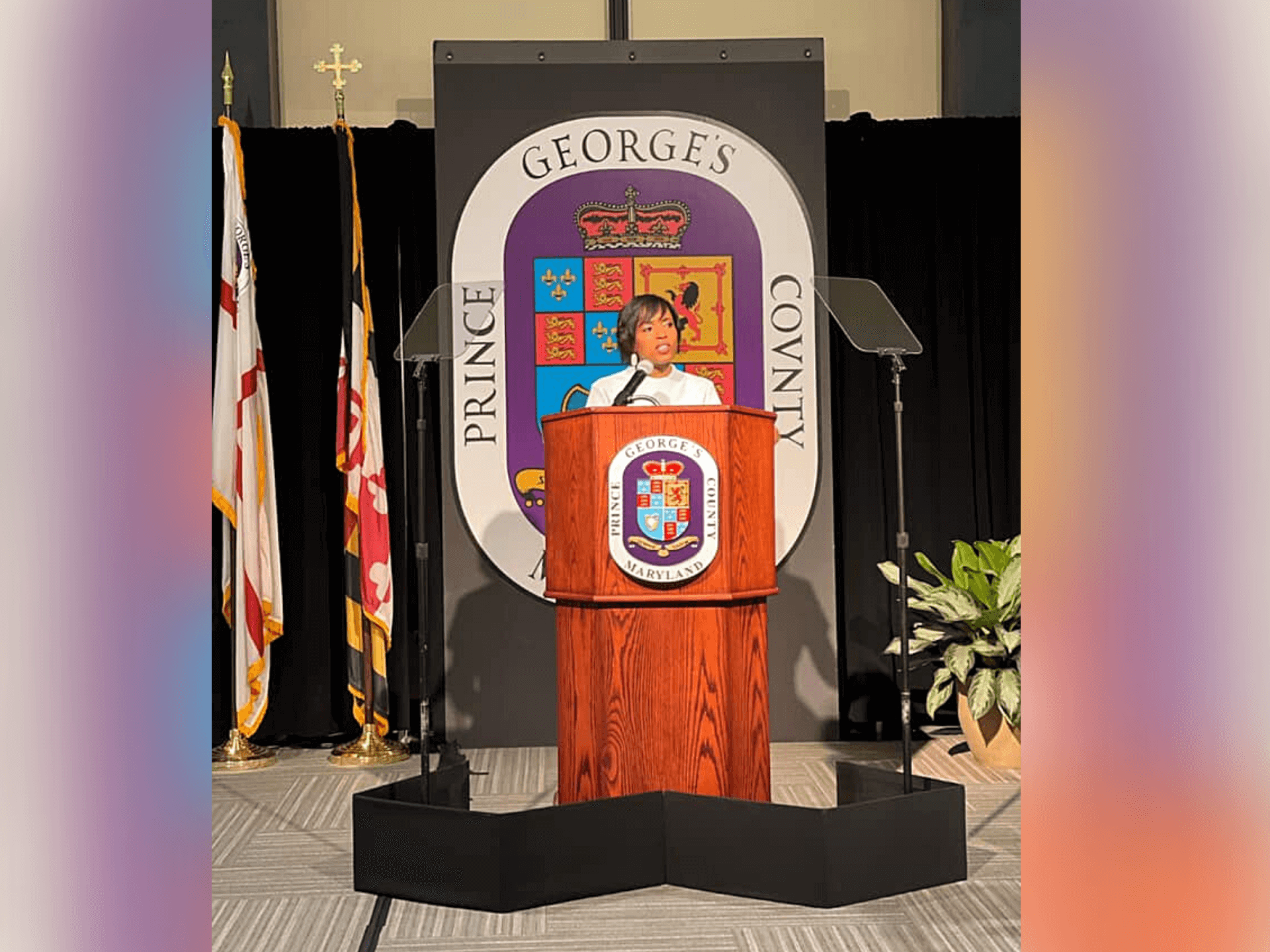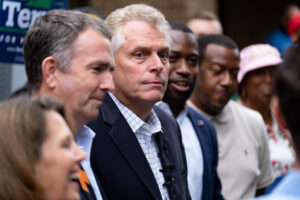
It should come as a surprise to nobody, but Angela D. Alsobrooks (D) is really leaning into her role as Prince George’s County executive now that she has publicly declared that she isn’t going to run for governor in 2022.
In fact, ironically, Alsobrooks’ State of the County address last week had all the trappings of a gubernatorial address, including an enthusiastic, live prime-time audience. It also happened to be chock-full of substance.
One of the notable things about all the federal bounty heading to state and local governments is that local political leaders like Alsobrooks will have an opportunity to do some really creative things in the next few years.
Alsobrooks’ agenda, heavy on economic development, is focused and ambitious. It fairly screams, for better or worse, that the county is ready to play in the big leagues when it comes to competing with other jurisdictions in the state and regionally. Is anybody willing to bet against Alsobrooks at this point?
Like every other state and local official, Alsobrooks has mainly been preoccupied with managing the most desperate conditions brought on by the COVID-19 public health and economic crises. But unlike some of her counterparts, she also had the foresight to look ahead.
“In many ways, 2020 was the hardest year our county ever faced,” she said last week. “And I’d also dare to say that it’s the one that we’ve been waiting for.”
Fairly early in the pandemic, Alsobrooks convened a task force called Prince George’s Forward to help her chart a vision for the county’s future. Led by Charlene Dukes, the former president of Prince George’s Community College, and David Velazquez, the president of Pepco Holdings, the 50-member task force broke into five different work groups to dive deeply into certain topic areas.
And the leaders of each subcommittee were distinguished in their own right: Thomas Graham, the former Pepco executive and director of Goodwill of Greater Washington, for economic recovery; Darryll Pines, president of the University of Maryland College Park, for education recovery; Joseph Wright, senior vice president and chief medical officer of Capital Region Health within the University of Maryland Medical System, for health recovery; Rosie Allen-Herring, the president and CEO of United Way of the National Capital Area, for human and social services recovery; and even former Gov. Martin J. O’Malley (D), for government operations.
Not coincidentally, Prince George’s Forward delivered its final report the day before Alsobrooks gave her State of the County speech, and it undergirded many of her themes and specific proposals. This was an aspirational document in ways that Prince George’s — or most other Maryland jurisdictions — aren’t used to seeing.
But in an interview, Dukes and Velazquez were quick to point out that most of the several dozen recommendations, like creating more lending sources for minority entrepreneurs, sustainable financing for school infrastructure, and stronger cybersecurity programs for local government, are doable; some are already paid for and don’t require legislative action.
Dukes and Velasquez both touted the recommendations and the process that made the document happen. “We did not receive one negative response,” Dukes said.
After all but deciding not to run for governor in 2022, Alsobrooks briefly reconsidered this spring, because she saw the awesome powers that the governor possesses, especially during a crisis like the pandemic, and she pondered whether she could best help Prince George’s by going for the state’s top job. Ultimately, out of a sense of duty and for personal reasons, including the fact that her daughter is still in high school, Alsobrooks decided to seek a second term as county executive instead.
That development is Prince George’s County residents’ gain — and possibly, for the discourse of the 2022 Democratic primary for governor, the state’s loss. But Alsobrooks in a way has also ratcheted up expectations. Assuming she’s reelected — a fairly safe bet — it’s now up to her to deliver on the big dreams and the county’s promise.
The work of the Prince George’s Forward task force is officially over. But the members will continue to spread the word.
“We all feel a vested interest in making sure that these recommendations are carried forward,” Velazquez said.
Said Alsobrooks, “Their work laid the foundation for greatness.”
A Miller’s tale
Speaking of Prince George’s, the old adage that success has a thousand fathers and mothers was on dramatic display last week when the ribbon was cut at the new University of Maryland Capital Region Medical Center in Largo.
This plan was hatched decades ago, and is finally coming to fruition. Several of the dignitaries there, from Gov. Lawrence J. Hogan Jr. (R) on down, had reason to boast. But remember, Hogan threw a wrench in the process a few years back and cut funding for the project one year. The late state Senate President Thomas V. Mike Miller Jr. (D) leaned heavily on Hogan to make the money available and also persuaded a reluctant University of Maryland Medical System board to bring the Prince George’s Hospital into its network.
There is now a consequential state-of-the-art medical facility in the central part of the county — which happens to be an integral piece of Alsobrooks’ vision for a more robust Prince George’s economy. It also may be one of the last tangible signs of Miller’s vast influence in the county he served for five decades.
The next question is, what will become of the existing hospital building, now empty, on a hillside in Cheverly overlooking the Baltimore-Washington Parkway? That is bound to become one of the most intriguing development debates in the state over the next couple of years.
Yes, Virginia
There aren’t too many political similarities between Maryland and Virginia. Nevertheless, it’s worth asking: Are there any lessons to be learned in Maryland from last week’s Democratic primaries in the Old Dominion? They were, after all, the first full-scale primaries since the 2020 presidential election.

Former Virginia Gov. Terry McAuliffe (D), center, campaigning recently in Richmond. Photo by Ned Oliver/Virginia Mercury.
At first glance, Terry McAuliffe’s big victory in the Democratic primary for governor has got to warm Maryland Comptroller Peter V.R. Franchot’s heart. McAuliffe is a known political entity, a happy warrior, a rich guy, who has been on the scene in one way or another for many years, and he has used both his official role and his political operations to spread goodwill around the state.
But maybe there’s some good news in his victory for Tom Perez as well. Perez, like McAuliffe, is a former Democratic National committee chair with a combination of progressive stances, establishment support, and inside connections.
McAuliffe competed in the primary against three Black candidates — including Lt. Gov. Justin Fairfax, hobbled by a personal scandal, and two female Black lawmakers — and a white legislator who labeled himself a socialist.
Between McAuliffe and the No. 3 finisher, state Sen. Jennifer McClellan, the so-called establishment candidates combined for 73% of the primary vote. That’s something for Maryland Democrats to think about as the candidates running for governor here scramble to outflank their opponents on the left.
Remember, it’s a rare multi-candidate primary in Maryland when the most progressive contender wins. Ben Jealous’ primary victory in the 2018 gubernatorial election was an exception to the rule.
Of course, McAuliffe is running in an election following eight years of Democratic governors in Richmond (and 16 years of Democratic governors out of the last 20), whereas in Maryland, Democrats are looking to reclaim Government House after eight years of Hogan. Does this make the Democratic primary electorate more restive? Will primary voters think pragmatically about the candidate who is likeliest to prevail in a general election? Or will they be anxious to reward someone who can who makes the best case to move on from eight placid Hogan years?
Do primary voters punish Franchot, regardless of the platform he’s peddling, because he more than most Democrats worked to advance the narrative that Hogan is a friendly bipartisan fellow? And what about the racial, ethnic, and geographical considerations that go into determining the winner of every statewide Democratic primary? Stay tuned, as they say.
After Jake
The biggest surprise about the news that Yaakov “Jake” Weissmann is stepping down as chief of staff to Senate President Bill Ferguson (D-Baltimore City) — a job he held under Miller as well — was the timing. Ferguson has been tinkering with the inner workings of the Senate since taking over for Miller at the beginning of 2020, which is well within his right.
But with redistricting just around the corner, and with another tough campaign season on its heels, it’s somewhat mystifying that Ferguson wouldn’t view Weissmann, who has experience both with the redistricting process and with Senate campaigns, as a major asset.
Weissmann, who richly deserves some time off, is sure to land an important gig soon — probably in the political realm first, maybe on a consulting basis, before landing a more permanent position following the 2022 election. No doubt his phone is already ringing off the hook.




 Creative Commons Attribution
Creative Commons Attribution